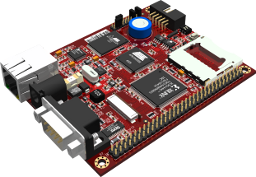Ethernut 3

The first 32 bit version of the Ethernut Open Source Hardware Family is packed with features like 8 MBytes NAND Flash and 256kBytes full speed SRAM, MMC/SD-Card Socket, user programmable logic etc. With the 32-Bit AT91R40008 CPU (ARM7TDMI) running at 73.728MHz, it is mainly targeted at performance intensive processing like real-time coding and decoding applications. A DM9000 controller is used for the 100 MBit Ethernet Interface.
Hardware Revisions
The board revision is printed in copper on the back side of the board.
Ethernut 3.0 Rev-D
This initial revision was published in October 2005.
Ethernut 3.0 Rev-E
In July 2006 a new revision had been introduced, which conforms to RoHS and fixes a few
problems of the previous board design.
Ethernut 3.1 Rev-D
The announcement of Xicor/Intersil to stop production of the combined RTC and EEPROM chip
used on Ethernut 3.0 required a redesign, which was published in October 2009.
Common Features
CPU
The AT91R40008 was one of the first ARM7TDMI microcontrollers offered by Atmel. Compared to the later SAM7 family, it provides very few peripherals only.
- Three 10-bit timer/counter
- Two USARTs
- Watchdog timer
There is also no internal Flash memory. But with 256 kByte on-chip SRAM providing 32-bit single cycle access at 72 MHz clock rate, Nut/OS applications are executed significantly faster than on more modern CPUs.
Memory
In addition to the internal 256 kByte SRAM, the board contains 4 Mbytes NAND Flash. In most applications program code will be copied from Flash to SRAM during initialization. The remaining Flash memory may be used for web contents or other constant data. Nevertheless, all or part of the program code may be directly executed in Flash at much lower speed, while critical parts of the code can still run in SRAM.
Ethernut 3.0 Rev-D offered 512 bytes EEPROM for non-volatile storage of configuration data. This had been increased to 32 kBytes on Rev-E, while on Ethernut 3.1 the EEPROM had been replaced by a 4 Mbytes serial DataFlash.
Last not least, a MultiMediaCard/SD-Card socket is available on all Ethernut 3 boards.
Ethernet
Davicom's DM9000E is used on Ethernut 3.0 for 10/100 Mbit Ethernet connectivity. With Ethernut 3.1 this had been replaced by the Davicom DM9000A with Auto-MDIX support.
Expandability
Like all Ethernuts, this board offers a 64-pin expansion port for attaching external custom hardware.
Although featuring a completely different CPU, all care has been taken to maintain compatibility with Ethernut 1 and Ethernut 2 for external hardware. Special functions like the memory bus, a secondary USART or the I2C and SPI busses are still located at the same expansion port pins. Note however, that technology was switched from 5V to 3.3V and that only the pins connected to the CPLD are 5V tolerant.
More...
This document explains how to setup Eclipse and OpenOCD to allow source code debugging of Nut/OS applications running on Ethernut 3.
To compensate the lean CPU peripherals, a Xilinx XC95144XL CPLD and a CY22393 programmable clock generator had been added. This allows to implement fast peripheral functions in hardware.
Intersil's X1226 or X1286 offers a realtime clock and calendar on Ethernut 3.0. It has been replaced by the NXP PCF8563 on Ethernut 3.1. All of them are backed up by a maintenance-free double layer capacitor.
See also
Ethernut 1
Minimalist embedded Ethernet Board.
Ethernut 2
Industrial board with extended temperature range and RS-485 interface.
Ethernut 5
Fast ARM9 board with large memory.
egnite GmbH
German company that sells Ethernut Boards and Kits.
